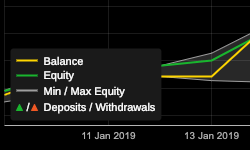US margin debt reaches an all-time high
Margin debt stood at $567.380 billion in January 2020 falling to as low as $479.29 billion in April. Previous highwater marks in the data were seen in May 2018 at $668.94 billion

In another sign that US equity markets may be topping out the level of margin debt in US equity markets has hit an all-time high.
FINRA, the Financial Industry Regulatory Authority has published its monthly margin and debt balance data which shows that US investors have borrowed $722.10 billion against securities held in their portfolios during November.
That figure rose sharply from October’s $659.32 billion a gain of around 9.00%. Margin debt stood at $567.38 billion in January 2020 falling to as low as $479.29 billion in April following the sharp enquiry market sell-off in March. Previous highwater marks in the data were seen in May 2018 at $668.94 billion.
It’s not uncommon for US investors to collateralise the portfolios to provide them with cash which they typically re-invest in the stock market. It allows investors to play the market without having to sell down long term holdings. If managed sensibly borrowing against an established portfolio can help to free up cash which can be deployed or put to work elsewhere.
However, issues can arise when investors borrow against a portfolio of speculative or highly rated stocks and then invest the cash raised into more of the same, or into leveraged instruments such as geared ETFs or options.
That can create nested leveraged structures which can collapse like a house of cards, should the markets move against traders with those type of positions open. Though that’s true of any leveraged investment strategy that focuses, rather than diversifying risk.
The sharp growth in margin debt balances, that is the amount of borrowed money outstanding, which is up by 28.15% from November 2019, can partly be explained by the performance of the underlying equity markets during 2020.
The average US equity index has returned just over 15% year to date, roughly in line with the performance of the broad-based S&P 500 index. Though the technology-laden Nasdaq 100 and Nasdaq Composite indices are up by 47.0% and 43.80% respectively over 2020.
Whilst outstanding margin debit balances in the US are not at extreme readings when measured as a percentage of total US equity market capitalisation. In fact, they are well below the peaks of 2007/8. They are, however, back at the high points seen in 2008 when measured by the yearly change in dollar term according to data from Yardeni Research.
High levels of margin debt are not necessarily a sell signal in US equities but they do shed light on the mindset of US inventors and their risk appetites. What’s more, they suggest that any market correction could be exacerbated by forced selling needed to meet margin calls on outstanding loans, which in turn can lead to higher volatility.
That prospect could help to explain why the CBOE VIX index, the most well-known measure of implied US equity volatility, has remained above a reading of 20 for well over 200 days in 2020. I also note that before the end of February 2020, the 200-day moving average in the VIX could be found at levels between 15 and 16 index points. While risk appetites remain elevated among US investors measures of volatility are likely to remain heightened as well it seems.









